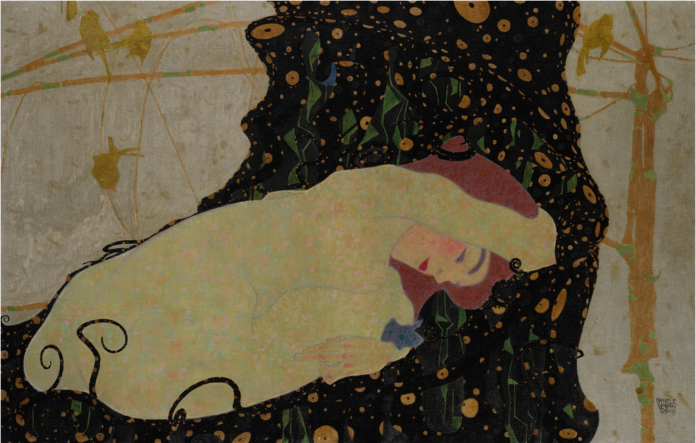In this ongoing series for Fine Art Today, we take a longer look at the history and features of a soon-to-be-available artwork of note. This week we feature an outstanding example of modern expressionism.
Representations of Danaë — the daughter of King Acrisius of ancient Greece, who was locked in a bronze prison until, according to legend, Zeus impregnated her in the form of a shower of golden coins — are found throughout art history. Since the myth’s conception in the first century BCE, artists have delighted in representing the character as a stunning contemporary female muse whose beauty was irresistible. Among the most popular artists who have chosen Danaë as their subject are Rembrandt, Gustav Klimt, Titian, Orazio Gentileschi, Comerre, and Correggio (just to name a few).
Like his compatriot Gustav Klimt, the controversial Viennese artist Egon Schiele (1890-1918) was also fascinated by the myth of Danaë, choosing her as his subject for a breathtaking 1909 painting that highlights Sotheby’s upcoming “Impressionist & Modern Art Evening Sale” on May 16 in New York City.
At first glance, one is immediately drawn to a large darkened object that sweeps from the upper center of the canvas to the bottom left. Placed within this mass is the cradled — perhaps hunched — form of Danaë herself. Within the black void are abstracted golden-metallic circular shapes that appear to rain down on Danaë. As expected in a masterpiece of Viennese Secessionist art, there is a captivating juxtaposition of flatness and three-dimensionality in the work, reminiscent of the iconic works of Gustav Klimt. The subject of the painting explains the figure’s unnatural pose. In fact, we can see that Danaë raises and covers her head in a protective gesture, shielding herself from the onslaught of golden coins.
Via Sotheby’s, “Painted in 1909, ‘Danaë’ is Egon Schiele’s greatest early masterpiece. It contains the first flowering of Schiele’s unique vision and voice. The jewel-like surface, the geometrical patterning and the broad expanses of color in the present work epitomize the lavishness and opulence of the Jugenstil decorative tradition. Here, Schiele focuses his great talent for figuration on Danaë’s hand, shoulder blade and right arm as well as the supreme delicacy of the figure’s facial features. His subtle usage of varied coloration in her flesh contrasts sharply with the gold, green and black shower of Zeus. The mythological roots of the subject matter in the present work serve as a perfect backdrop for the highly-stylized execution and ambiguous space, while also allowing for a free use of the nude as subject matter.”
Those seeking to add this invaluable masterpiece to their own collection will need to realize a lot of value. Sotheby’s estimates the painting will sell for between $30 million and $40 million USD. To learn more, visit Sotheby’s.
This article was featured in Fine Art Today, a weekly e-newsletter from Fine Art Connoisseur magazine. To start receiving Fine Art Today for free, click here.








